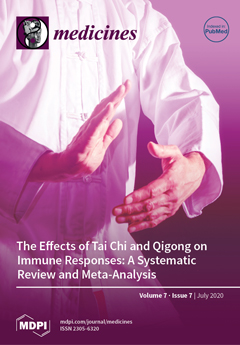Background: Effective preventative health interventions are essential to maintain well-being among healthcare professionals and the public, especially during times of health crises. Several studies have suggested that Tai Chi and Qigong (TQ) have positive impacts on the immune system and its response to inflammation. The aim of this review is to evaluate the current evidence of the effects of TQ on these parameters.
Methods: Electronic searches were conducted on databases (Medline, PubMed, Embase and ScienceDirect). Searches were performed using the following keywords: “Tai Chi or Qigong” and “immune system, immune function, immunity, Immun*, inflammation and cytokines”. Studies published as full-text randomized controlled trials (RCTs) in English were included. Estimates of change in the levels of immune cells and inflammatory biomarkers were pooled using a random-effects meta-analysis where randomised comparisons were available for TQ versus active controls and TQ versus non-active controls.
Results: Nineteen RCTs were selected for review with a total of 1686 participants and a range of 32 to 252 participants within the studies. Overall, a random-effects meta-analysis found that, compared with control conditions, TQ has a significant small effect of increasing the levels of immune cells (SMD, 0.28; 95% CI, 0.13 to 0.43,
p = 0.00), I
2 = 45%, but not a significant effect on reducing the levels of inflammation (SMD, −0.15; 95% CI, −0.39 to 0.09,
p = 0.21), I
2 = 85%, as measured by the systemic inflammation biomarker C-reactive protein (CRP) and cell mediated biomarker cytokines. This difference in results is due to the bidirectional regulation of cytokines. An overall risk of bias assessment found three RCTs with a low risk of bias, six RCTs with some concerns of bias, and ten RCTs with a high risk of bias.
Conclusions: Current evidence indicates that practising TQ has a physiologic impact on immune system functioning and inflammatory responses. Rigorous studies are needed to guide clinical guidelines and harness the power of TQ to promote health and wellbeing.
Full article




